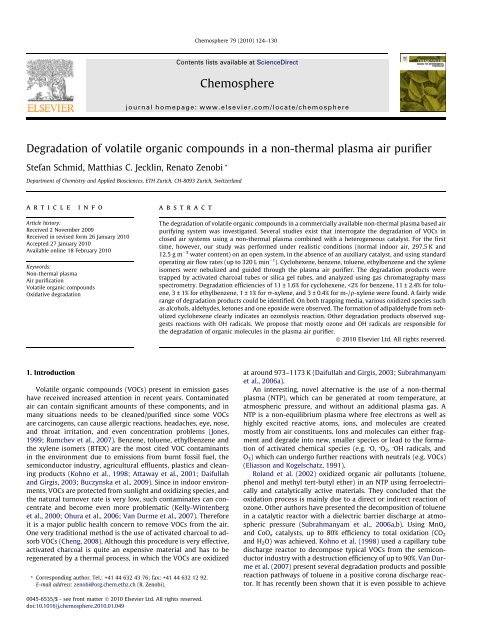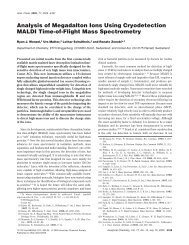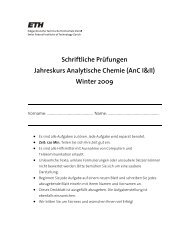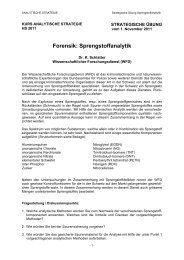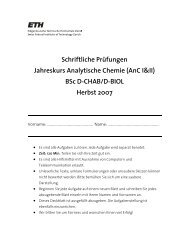Degradation of volatile organic compounds in a ... - Renato Zenobi
Degradation of volatile organic compounds in a ... - Renato Zenobi
Degradation of volatile organic compounds in a ... - Renato Zenobi
Create successful ePaper yourself
Turn your PDF publications into a flip-book with our unique Google optimized e-Paper software.
Chemosphere 79 (2010) 124–130<br />
Contents lists available at ScienceDirect<br />
Chemosphere<br />
journal homepage: www.elsevier.com/locate/chemosphere<br />
<strong>Degradation</strong> <strong>of</strong> <strong>volatile</strong> <strong>organic</strong> <strong>compounds</strong> <strong>in</strong> a non-thermal plasma air purifier<br />
Stefan Schmid, Matthias C. Jeckl<strong>in</strong>, <strong>Renato</strong> <strong>Zenobi</strong> *<br />
Department <strong>of</strong> Chemistry and Applied Biosciences, ETH Zurich, CH-8093 Zurich, Switzerland<br />
article<br />
<strong>in</strong>fo<br />
abstract<br />
Article history:<br />
Received 2 November 2009<br />
Received <strong>in</strong> revised form 26 January 2010<br />
Accepted 27 January 2010<br />
Available onl<strong>in</strong>e 18 February 2010<br />
Keywords:<br />
Non-thermal plasma<br />
Air purification<br />
Volatile <strong>organic</strong> <strong>compounds</strong><br />
Oxidative degradation<br />
The degradation <strong>of</strong> <strong>volatile</strong> <strong>organic</strong> <strong>compounds</strong> <strong>in</strong> a commercially available non-thermal plasma based air<br />
purify<strong>in</strong>g system was <strong>in</strong>vestigated. Several studies exist that <strong>in</strong>terrogate the degradation <strong>of</strong> VOCs <strong>in</strong><br />
closed air systems us<strong>in</strong>g a non-thermal plasma comb<strong>in</strong>ed with a heterogeneous catalyst. For the first<br />
time, however, our study was performed under realistic conditions (normal <strong>in</strong>door air, 297.5 K and<br />
12.5 g m 3 water content) on an open system, <strong>in</strong> the absence <strong>of</strong> an auxiliary catalyst, and us<strong>in</strong>g standard<br />
operat<strong>in</strong>g air flow rates (up to 320 L m<strong>in</strong> 1 ). Cyclohexene, benzene, toluene, ethylbenzene and the xylene<br />
isomers were nebulized and guided through the plasma air purifier. The degradation products were<br />
trapped by activated charcoal tubes or silica gel tubes, and analyzed us<strong>in</strong>g gas chromatography mass<br />
spectrometry. <strong>Degradation</strong> efficiencies <strong>of</strong> 11 ± 1.6% for cyclohexene,
S. Schmid et al. / Chemosphere 79 (2010) 124–130 125<br />
complete decomposition <strong>of</strong> VOCs us<strong>in</strong>g thermal plasmas (Indarto<br />
et al., 2008).<br />
The goal <strong>of</strong> this work was to study a commercially available<br />
plasma air purifier Askair Decohesion Processor (ADP, Askokoro,<br />
Switzerland), which is based on an NTP and works with a high<br />
AC voltage (3–8 kV) at 50 Hz. Such air purifier systems are ma<strong>in</strong>ly<br />
considered for the purification <strong>of</strong> <strong>in</strong>door air and for destroy<strong>in</strong>g<br />
VOCs as well as liv<strong>in</strong>g species such as microorganism or viruses.<br />
We <strong>in</strong>vestigated how the ADP degrades <strong>organic</strong> pollutants and<br />
which chemical reactions are responsible for the decomposition<br />
<strong>of</strong> the contam<strong>in</strong>ant molecules. To reduce the complexity and to<br />
establish the reaction mechanisms operat<strong>in</strong>g <strong>in</strong> the ADP, our studies<br />
were carried out with small, <strong>volatile</strong>, <strong>organic</strong> molecules, cyclohexene<br />
and BTEX. The degradation products <strong>of</strong> these typical VOCs<br />
clearly <strong>in</strong>dicate that oxidative reactions must be responsible for<br />
the decomposition.<br />
2. Experimental<br />
2.1. Air purify<strong>in</strong>g system<br />
The experimental setup <strong>of</strong> the experimental air purify<strong>in</strong>g system<br />
is shown <strong>in</strong> Fig. 1A. The air flow is from left to right and the<br />
first component (1) is a HEPA (filter class H13, camfil, Re<strong>in</strong>feld,<br />
Germany) filter which purifies the air before it enters the system<br />
to make sure that no contam<strong>in</strong>ation from the outside is collected.<br />
Component (2) is the fan (Vortice L<strong>in</strong>eo 125 V0, VORTICE, Tribiano,<br />
Italy) generat<strong>in</strong>g an air flow which is cont<strong>in</strong>uously adjustable from<br />
0 to 360 m 3 h 1 . An <strong>in</strong>terface (3) made <strong>of</strong> polyv<strong>in</strong>yl chloride (PVC),<br />
connects the fan (<strong>in</strong>ner diameter (ID) 125 mm) to the ADP (ID<br />
150.6 mm). The tube <strong>in</strong> the middle <strong>of</strong> the system with the two w<strong>in</strong>dows<br />
is a 40 cm long PVC tube (5) with an ID <strong>of</strong> 150.6 mm which<br />
conta<strong>in</strong>s two <strong>in</strong>lets: one for the nitrogen gas to operate the nebulizer,<br />
and the second one to a motor driven syr<strong>in</strong>ge pump which<br />
provides the sample solution for the nebulizer. The nebulizer (4) itself<br />
is located exactly <strong>in</strong> the middle <strong>of</strong> the system to generate the<br />
best homogeneous nebulization possible. The two w<strong>in</strong>dows allow<br />
observ<strong>in</strong>g and adjust<strong>in</strong>g the nebulizer spray for optimiz<strong>in</strong>g it. The<br />
water content <strong>of</strong> the <strong>in</strong>com<strong>in</strong>g air was cont<strong>in</strong>uously measured with<br />
a hygrometer (Extech 445815, Conrad, Switzerland).<br />
Fig. 1B shows an exploded view <strong>of</strong> the ADP. Dimensions and<br />
technical specifications are: diameter 160 mm, length 180 mm;<br />
overall weight 10.5 kg; materials <strong>of</strong> construction: nickel, lead, copper,<br />
PVC and poly-(methyl-methacrylate); power consumption:<br />
17.3 W (root-mean-square); power supply: 230 V, 50 Hz. An operat<strong>in</strong>g<br />
voltage <strong>of</strong> 8 kV was used to maximize the degradation efficiency;<br />
the normal recommended operat<strong>in</strong>g voltage is 6.1 kV,<br />
result<strong>in</strong>g <strong>in</strong> much less O 3 production. The plasma is generated <strong>in</strong><br />
normal air without any auxiliary gas. The air velocity <strong>in</strong> the system<br />
is measured with an anemometer (PCE group, Germany) before<br />
and after the ADP. The sampl<strong>in</strong>g funnel (C) with an ID <strong>of</strong><br />
52.5 mm is located exactly <strong>in</strong> the middle <strong>of</strong> the 20 cm long tube<br />
at the end and will be discussed later. The other end <strong>of</strong> the sampl<strong>in</strong>g<br />
device is connected to adsorb<strong>in</strong>g tubes which are coupled<br />
to a vacuum pump (DIVAC membrane pump 2.2 L, Wexford, Ireland).<br />
The aspirated flow was measured with a flow meter and<br />
was varied between 0.1 and 3.5 L m<strong>in</strong> 1 by us<strong>in</strong>g a pressure reduc<strong>in</strong>g<br />
valve. An ozone monitor (Model C-30ZK, Ecosensors, Netherlands)<br />
was placed after the air outlet <strong>of</strong> our setup (after No. 9 <strong>in</strong><br />
Fig. 1A) for ozone detection.<br />
2.2. Sample <strong>in</strong>troduction/nebulization<br />
For sample nebulization a system similar to a sonic spray ionization<br />
source (Takats et al., 2003) was constructed. A fused silica<br />
capillary with an ID <strong>of</strong> 150 lm and an outer diameter (OD) <strong>of</strong><br />
375 lm was used for sample <strong>in</strong>fusion. The capillary for the nebuliz<strong>in</strong>g<br />
gas had an ID <strong>of</strong> 530 lm and an OD <strong>of</strong> 700 lm. Both capillaries<br />
were sealed <strong>in</strong> a sta<strong>in</strong>less steel T-piece (Swagelok) with<br />
polytetrafluoroethylene (PTFE) ferrules. A 1.5875 mm (1/16”) SS<br />
tub<strong>in</strong>g was used to deliver the nebuliz<strong>in</strong>g gas. This home-made<br />
nebulizer was fixed <strong>in</strong> the center <strong>of</strong> tube (4) (cf. Fig. 1A). Nitrogen<br />
was used as nebulizer gas, and the flow rate was varied from 0.45<br />
to 1.25 L m<strong>in</strong> 1 . A syr<strong>in</strong>ge pump (model 4400–001, Harvard Apparatus,<br />
USA) was used for sample <strong>in</strong>troduction. The sett<strong>in</strong>gs <strong>of</strong> the<br />
syr<strong>in</strong>ge pump were the follow<strong>in</strong>g: diameter, 14.57 mm; sample<br />
flow speed, 5–20 lL m<strong>in</strong> 1 ; target volume 2000, 500 or 250 lL.<br />
The sample nebulization with this technique was found to be very<br />
reproducible (stable spray and good area coverage <strong>of</strong> the ADP) and<br />
the sample flow rate as well as the sampl<strong>in</strong>g time could simply be<br />
adjusted us<strong>in</strong>g a syr<strong>in</strong>ge pump. The usage <strong>of</strong> a syr<strong>in</strong>ge (1010 LTN<br />
10 mL, HAMILTON, Boeckten, Switzerland) made <strong>of</strong> glass did not<br />
allow high sample flow rates (not higher than 500 lL m<strong>in</strong> 1 ) due<br />
to the high back pressure from the capillary (ID 150 lm). With a<br />
0.2 g L 1 solution <strong>of</strong> brilliant <strong>of</strong> blue R (Bio-Rad Laboratories,<br />
USA) the optimum spray distance was experimentally determ<strong>in</strong>ed.<br />
By spray<strong>in</strong>g the blue dye solution onto a white paper, an optimum<br />
distance <strong>of</strong> 40 cm was found, at which the whole cross section <strong>of</strong><br />
the ADP was covered.<br />
2.3. Sampl<strong>in</strong>g approach<br />
Fig. 1. (A) Schematic <strong>of</strong> the air purify<strong>in</strong>g system setup. (1), HEPA filter; (2),<br />
cont<strong>in</strong>uously adjustable fan (0–360 m 3 h 1 ); (3), polyv<strong>in</strong>yl chloride (PVC) <strong>in</strong>terface;<br />
(4), Nebulizer; (5), 400 mm long PVC tube with two Plexiglas w<strong>in</strong>dows; (6), holes<br />
for measur<strong>in</strong>g the air velocity with an anemometer; (7), 200 mm long PVC tube; (9),<br />
PVC tube connected with a funnel for the collection <strong>of</strong> the <strong>compounds</strong> after the ADP.<br />
(B) Exploded view <strong>of</strong> the plasma air purifier (Askokoro, Switzerland); (8), specially<br />
designed copper plates where AC high voltage is applied; (9), Plexiglas spacers. (C)<br />
Schematic <strong>of</strong> the sampl<strong>in</strong>g system; (10), PVC holder; (11), poly(tetrafluorethylene)<br />
(PTFE) funnel OD 52.5 mm and ID 49 mm; (12), O-r<strong>in</strong>g seals allow the connection<br />
with a 6 mm ID PTFE tube; (13), PTFE tube with an ID <strong>of</strong> 6 mm connected to the<br />
sampl<strong>in</strong>g tubes; (14), alum<strong>in</strong>um block to fix the PTFE funnel with the PVC tube.<br />
The sampl<strong>in</strong>g funnel (Fig. 1C) was placed 150 mm beh<strong>in</strong>d the<br />
ADP and was fixed <strong>in</strong>side the system by a PVC holder. The funnel<br />
(11) was made <strong>of</strong> PTFE and was connected to the PVC holder (10)<br />
<strong>in</strong>side an alum<strong>in</strong>um block (14) via an O-r<strong>in</strong>g seal (12) that allows<br />
a tight connection with a PTFE tube (13, ID 6 mm, which is exactly<br />
the <strong>in</strong>ner diameter <strong>of</strong> the funnel). This is to avoid any gaps and<br />
edges, where sample could accumulate. The other end <strong>of</strong> this PTFE<br />
tube (ID 6 mm) is connected to trapp<strong>in</strong>g media <strong>in</strong> tubes, which are<br />
coupled to the high vacuum pump. Two types <strong>of</strong> adsorbents were
126 S. Schmid et al. / Chemosphere 79 (2010) 124–130<br />
used: (i) charcoal type G (750 mg sampl<strong>in</strong>g medium and 250 mg<br />
control medium) and (ii) silica gel type G sampl<strong>in</strong>g tubes<br />
(1100 mg sampl<strong>in</strong>g medium and 450 mg control medium. The<br />
sampl<strong>in</strong>g efficiency such sampl<strong>in</strong>g tubes can be shown to be nearly<br />
100% us<strong>in</strong>g the control layer (0.1 L m<strong>in</strong> 1 aspiration flow). Also, the<br />
manufacturer grantees that the pressure drop <strong>in</strong>duced by the sampl<strong>in</strong>g<br />
tube is 99.7%, Sigma–Aldrich, Switzerland), toluene (>99.7%,<br />
Fluka, Switzerland), cyclohexene p.a. (Fluka, Switzerland), ethyl<br />
benzene p.a., and xylene isomers p.a. (mixture, house stock),<br />
chlor<strong>of</strong>orm (>99.7%, Fluka, Switzerland) and carbon disulfide for<br />
analysis (Merck, Darmstadt, Germany) were used. The sample flow<br />
rate was either 5 lL m<strong>in</strong> 1 (correspond<strong>in</strong>g concentration 1.5 <br />
10 7 M), 10 lL m<strong>in</strong> 1 (3.0 10 7 M), or 15 lL m<strong>in</strong> 1 (4.5 <br />
10 7 M); a nebuliz<strong>in</strong>g gas flow rate <strong>of</strong> 1.0 L m<strong>in</strong> 1 was used dur<strong>in</strong>g<br />
all measurements. To be able to see degradation products 2.0 mL <strong>of</strong><br />
BTEX as well as cyclohexene were studied <strong>in</strong> the ADP us<strong>in</strong>g a sample<br />
flow rate <strong>of</strong> 5 lL m<strong>in</strong> 1 . For every experiment a negative control<br />
experiment with the ADP switched <strong>of</strong>f was done.<br />
To evaluate the efficiency <strong>of</strong> the ADP, two experiments were<br />
performed for all <strong>compounds</strong>: a negative control experiment, and<br />
an experiment with activated air purifier. 250 lL <strong>of</strong> cyclohexene<br />
and 500 lL <strong>of</strong> BTEX, respectively, were nebulized for this purpose.<br />
Charcoal type G sampl<strong>in</strong>g tubes were used to adsorb the VOCs after<br />
the activated ADP as these are optimal for the collection <strong>of</strong> nonpolar<br />
substances. Cumene p.a. (Fluka, Switzerland) was used as an<br />
<strong>in</strong>ternal standard and was added to the desorption solvent <strong>in</strong> a ratio<br />
<strong>of</strong> 1–5000.<br />
For desorption <strong>of</strong> the sample from the adsorbents, the tubes<br />
were broken very carefully, and the sample layer (750 mg activated<br />
charcoal, 1100 mg silica gel, respectively) was transferred<br />
<strong>in</strong>to a 3.0 mL glass vial with screw cap. 2.0 mL carbon disulfide<br />
(CS 2 , cooled at 253 K to avoid boil<strong>in</strong>g <strong>of</strong> CS 2 before the vial is<br />
closed) <strong>in</strong> case <strong>of</strong> the charcoal tubes, and chlor<strong>of</strong>orm <strong>in</strong> case <strong>of</strong><br />
the silica gel tubes were pipetted <strong>in</strong>to the vial, which was closed<br />
immediately. The vials were then put <strong>in</strong>to an ultra sonic bath for<br />
30 m<strong>in</strong> to desorb the trapped <strong>compounds</strong>. The result<strong>in</strong>g solution<br />
was first centrifuged to get rid <strong>of</strong> any rema<strong>in</strong><strong>in</strong>g particles. 200 lL<br />
<strong>of</strong> the clear supernatant were then transferred <strong>in</strong>to vials. 1.0 lL<br />
<strong>of</strong> each sample was afterwards <strong>in</strong>jected <strong>in</strong>to gas chromatography<br />
mass spectrometry apparatus (GS–MS) us<strong>in</strong>g pulsed splitless <strong>in</strong>jection<br />
(100 kPa <strong>in</strong>jection pulse pressure until 0.5 m<strong>in</strong>).<br />
Optima-5-MS column (50 m 0.20 mm 0.35 lm, Macherey–Nagel,<br />
Düren, Germany) and an auto sampler model GERSTEL. The column<br />
was used with a He flow <strong>of</strong> 5.7 mL m<strong>in</strong> 1 and a pressure <strong>of</strong><br />
194.3 kPa. Separation was achieved us<strong>in</strong>g a temperature program<br />
start<strong>in</strong>g with 323 K, hold<strong>in</strong>g this temperature for 5 m<strong>in</strong>, <strong>in</strong>creas<strong>in</strong>g<br />
to 473 K with a temperature gradient <strong>of</strong> 10 K m<strong>in</strong> 1 , which allowed<br />
measurements with<strong>in</strong> 22 m<strong>in</strong>. The temperature sett<strong>in</strong>gs for the two<br />
systems were the follow<strong>in</strong>g: <strong>in</strong>let 573 K, MS source 503 K, MS Quad<br />
423 K and Aux-2 temperature 553 K.<br />
Both GC–MS systems were equipped with the mass spectral reference<br />
library from the National Institute <strong>of</strong> Standards and Technology<br />
(NIST version 2.0a). Only substances with a confidence<br />
>50% for identification via the NIST library were considered for<br />
evaluation and discussion <strong>of</strong> the plasma degradation process. The<br />
decomposition efficiencies <strong>of</strong> BTEX and cyclohexene were measured<br />
quantitatively us<strong>in</strong>g cumene as <strong>in</strong>ternal standard, whereas<br />
the degradation products were measured qualitatively and afterwards<br />
identified with the NIST database. Limits <strong>of</strong> detection were<br />
not determ<strong>in</strong>ed but are depend<strong>in</strong>g on the <strong>in</strong>strumentation, <strong>in</strong> the<br />
range <strong>of</strong> 0.5–0.8 lg VOC per sample (NIOSH, 2009 National Institute<br />
for Occupational Safety and Health).<br />
3. Results and discussion<br />
3.1. <strong>Degradation</strong> efficiency <strong>of</strong> the ADP<br />
First, a mixture <strong>of</strong> BTEX (1:1:1:1) as well as cyclohexene was<br />
measured with and without the ADP activated to obta<strong>in</strong> <strong>in</strong>formation<br />
about the degradation efficiency <strong>of</strong> the plasma air purifier.<br />
Three <strong>in</strong>dependent experiments <strong>of</strong> BTEX and cyclohexene were<br />
performed. Low compound load<strong>in</strong>gs were used for these quantitative<br />
measurements, <strong>in</strong> order to not saturate the trapp<strong>in</strong>g media;<br />
this is, however, not optimal for detect<strong>in</strong>g small quantities <strong>of</strong> degradation<br />
products. 500 lL <strong>of</strong> BTEX and 250 lL cyclohexene respectively<br />
delivered with a sample flow rate <strong>of</strong> 5 lL m<strong>in</strong> 1 (were<br />
nebulized with 1.0 L m<strong>in</strong> 1 nitrogen. The air velocity, monitored<br />
with the anemometer after the ADP (B <strong>in</strong> Fig. 1A), was adjusted<br />
to 0.3 m s 1 , which corresponds to 16 ppb cyclohexene when a<br />
5 lL m<strong>in</strong> 1 <strong>in</strong>fusion rate was used. When turned on, the ADP was<br />
operated at a voltage <strong>of</strong> 8.0 kV. Higher voltages were not used, because<br />
breakdown occurs <strong>in</strong> the ADP and a spark bridges the gap between<br />
the two electrodes where the high voltage is applied. The<br />
degradation efficiencies <strong>of</strong> BTEX and cyclohexene are shown <strong>in</strong><br />
Fig. 2. The efficiency was calculated by normaliz<strong>in</strong>g the observed<br />
2.5. Sample analysis by GC–MS<br />
Analysis <strong>of</strong> the samples was done with two different GC–MS systems<br />
manly to save time. The first system was an Agilent Technologies<br />
7890A GC coupled with a 5975 <strong>in</strong>ert mass selective detector<br />
(Triple-Axis). A capillary column HP-5-MS (30 m 0.25 mm <br />
0.25 lm) was used with a He flow <strong>of</strong> 1.0 mL m<strong>in</strong> 1 and a pressure<br />
<strong>of</strong> 50 kPa. The separation was done with a temperature program<br />
start<strong>in</strong>g at 308 K, hold<strong>in</strong>g this temperature for 10 m<strong>in</strong>, <strong>in</strong>creas<strong>in</strong>g<br />
to 473 K with a temperature gradient <strong>of</strong> 20 K m<strong>in</strong> 1 and hold<strong>in</strong>g<br />
at 473 K for 1.75 m<strong>in</strong>. The total time was thus 20 m<strong>in</strong>. The second<br />
system was a HP 6890 GC with a HP 5973 MSD equipped with an<br />
Fig. 2. Efficiency <strong>of</strong> the ADP for BTEX and cyclohexene (n = 3). Collection was done<br />
on activated charcoal tubes. Carbon disulfide was used for desorption. System<br />
sett<strong>in</strong>gs: 500 lL sample, flow speed, 5 lL m<strong>in</strong> 1 ; air flow, 320 L m<strong>in</strong> 1 ; ADP, 8.0 kV<br />
50 Hz. An Agilent GC–MS 7890A system was used for sample analysis.
S. Schmid et al. / Chemosphere 79 (2010) 124–130 127<br />
signal area us<strong>in</strong>g the <strong>in</strong>ternal standard (cumene). The <strong>in</strong>tensity observed<br />
for the negative control experiment was then taken as 100%.<br />
The difference compared to the negative control was assigned to<br />
degraded analyte. A much higher degradation efficiency <strong>of</strong> the<br />
plasma was observed for cyclohexene and toluene (around 10%)<br />
than for the other five substances. Very similar degradation efficiencies<br />
were obta<strong>in</strong>ed for ethyl benzene and the xylene isomers.<br />
Almost no degradation was measured for benzene. This result<br />
shows that the attack <strong>of</strong> radicals only takes place on the side cha<strong>in</strong>s<br />
<strong>of</strong> the aromatic <strong>compounds</strong>, and not directly on a carbon atom <strong>in</strong><br />
the aromatic system. When consider<strong>in</strong>g the low power consumption<br />
(17.3 W), the degradation efficiencies are reasonable. However,<br />
degradation efficiencies <strong>of</strong> up to 70–100% us<strong>in</strong>g NTP (power<br />
consumption between 4 and 8 W) comb<strong>in</strong>ed with heterogeneous<br />
catalysts have been reported (Kohno et al., 1998; Holzer et al.,<br />
2002; Roland et al., 2002; Subrahmanyam et al., 2006a,b, 2007;<br />
Van Durme et al., 2007). A major drawback <strong>of</strong> such catalysts is that<br />
they can easily become deactivated by impurities and by the accumulation<br />
<strong>of</strong> solid byproducts (Indarto et al., 2008) such that they<br />
have to be replaced from time to time. This is not necessary when<br />
us<strong>in</strong>g the ADP. Moreover, <strong>in</strong> the references cited above, much lower<br />
air flow rates were used compared to our study: Roland et al.<br />
(2002) and Holzer et al. (2002) worked with an air flow rate <strong>of</strong><br />
0.1 L m<strong>in</strong> 1 , Subrahmanyam et al. (2007) used 0.5 L m<strong>in</strong> 1 , Kohno<br />
et al. (1998) 9 L m<strong>in</strong> 1 and Van Durme et al. (2007) 10 L m<strong>in</strong> 1 .<br />
In the work presented here an air flow rate <strong>of</strong> 320 L m<strong>in</strong> 1 was<br />
used, s<strong>in</strong>ce this is <strong>in</strong> the range <strong>of</strong> the actual air velocity (0.3–3 m<br />
s 1 ) <strong>in</strong> a practical ADP usage scenario. Of course, the dwell time<br />
<strong>of</strong> the analyte molecules <strong>in</strong> the plasma region is a lot shorter <strong>in</strong> this<br />
case (
128 S. Schmid et al. / Chemosphere 79 (2010) 124–130<br />
Adsorption was achieved us<strong>in</strong>g silica gel tubes. The GC–MS chromatograms<br />
<strong>of</strong> this experiment with and without activated ADP<br />
are shown <strong>in</strong> Fig. 3.<br />
Substances with a confidence <strong>of</strong> 50% us<strong>in</strong>g the NIST library: 1-phenylethanol and acetophenone.<br />
These two products almost co-elute but are clearly dist<strong>in</strong>guishable<br />
by GC–MS and <strong>in</strong>dicate an oxidative process, most likely <strong>in</strong>volv<strong>in</strong>g<br />
OH radicals. The humidity dur<strong>in</strong>g our experiments was determ<strong>in</strong>ed<br />
to be <strong>in</strong> the 10–14 g m 3 range, i.e., the formation <strong>of</strong> OH radicals<br />
due to reaction <strong>of</strong> H 2 O with exited NO 2 is very probable (Li et al.,<br />
2008). Moreover, processes due to collisions <strong>of</strong> H 2 O with electrons,<br />
such as dissociative excitation <strong>of</strong> H 2 O or dissociative electron<br />
attachment can also lead to OH radical formation (Champion,<br />
2003; Itikawa and Mason, 2005). An H-atom abstraction from the<br />
C–H bond <strong>of</strong> the ethyl group <strong>in</strong>duced by OH radicals, followed by<br />
further reaction with O 2 catalyzed by NO has been reported to be<br />
a possible reaction <strong>of</strong> ethylbenzene to acetophenone (Obermeyer<br />
et al., 2009). It is very likely that this reaction occurred <strong>in</strong> the<br />
ADP. Based on the work by Eliasson and Kogelschatz (1991), we assume<br />
an electron transfer from the plasma region to the air molecules<br />
(which are <strong>in</strong> a huge excess compared to the analyte), to form<br />
reactive species such as O, O 2 ,O 3 , OH, which then react with the<br />
analyte molecules.<br />
3.3. Cyclohexene – sampl<strong>in</strong>g with activated charcoal tubes<br />
Among all VOCs <strong>in</strong>vestigated, the highest degradation (cf. Fig. 2)<br />
and also the highest variety <strong>of</strong> degradations products were observed<br />
for cyclohexene. Activated charcoal tubes were used <strong>in</strong> this<br />
experiment to adsorb nonpolar products created by the ADP. The<br />
chromatogram <strong>of</strong> the products from degradation <strong>of</strong> cyclohexene<br />
is shown <strong>in</strong> Fig. 4A. One drawback <strong>of</strong> the sampl<strong>in</strong>g method used<br />
is that highly <strong>volatile</strong> substances as well as H 2 O and CO x cannot<br />
be detected due to the desorption solvent (CS 2 ) which itself leads<br />
to a huge <strong>in</strong>jection signal. Therefore, <strong>in</strong>formation is lost about very<br />
low molecular weight degradation products. Aga<strong>in</strong> only <strong>compounds</strong><br />
with a confidence <strong>of</strong> >50% were taken <strong>in</strong>to account. Nondegraded<br />
cyclohexene is observed after some solvent impurities<br />
(peak No. 1 <strong>in</strong> Fig. 4A). The <strong>compounds</strong> identified are listed <strong>in</strong> Table<br />
1, together with the structures, retention times, and confidences.<br />
Surpris<strong>in</strong>gly no major nitrogen conta<strong>in</strong><strong>in</strong>g degradation<br />
products were observed. Although there were some tentative identification,<br />
their matches with the NIST library were rather poor,<br />
and they fell through our selection criterion.<br />
Compound 5 was identified with a high confidence (78.9%) as<br />
cyclohex-2-enone, which is also a typical product <strong>of</strong> a reaction<br />
with OH radicals. Compound 4 strongly <strong>in</strong>dicates a reaction with<br />
ozone for the formation <strong>of</strong> oxiranes from O 3 react<strong>in</strong>g with isoprene,<br />
1,3-butadiene and a-p<strong>in</strong>ene (Atk<strong>in</strong>son, 2000). a-p<strong>in</strong>ene is structurally<br />
related to cyclohexene, which suggests this process to be feasible.<br />
Furthermore, it is well known that ozone is produced <strong>in</strong> NTPs<br />
<strong>in</strong> a three-body collision, with the third collision partner be<strong>in</strong>g O 2 ,<br />
O 3 ,O,N 2 or H 2 O(Eliasson and Kogelschatz, 1991; Magureanu et al.,<br />
2005; Van Durme et al., 2007). Moreover, one <strong>of</strong> the first NTP reactors<br />
was built specifically for generat<strong>in</strong>g ozone (Eliasson and<br />
Kogelschatz, 1991). Accord<strong>in</strong>g to the literature, this reaction occurs<br />
<strong>in</strong> a few microseconds. However, even dur<strong>in</strong>g such a short time<br />
other compet<strong>in</strong>g reactions like the formation <strong>of</strong> O 2 from O and<br />
O 3 are possible. We measured the ozone level <strong>in</strong> our setup <strong>in</strong> the<br />
exhaust air (after No. 9 <strong>in</strong> Fig. 1A) us<strong>in</strong>g the ozone monitor and<br />
found concentrations up to 1 ppm when a voltage <strong>of</strong> 8.0 kV was<br />
applied. The oxidized species found (cf. Table 1), together with<br />
the quite high ozone levels measured clearly support an oxidative<br />
reaction mechanism for the ADP.<br />
Table 1<br />
Signals identified with >50% confidence (accord<strong>in</strong>g to the NIST library) <strong>in</strong> the<br />
chromatogram shown <strong>in</strong> Fig. 4 (cyclohexene sampled on activated charcoal tubes<br />
after activated ADP), along with their retention time, structure and name, and NIST<br />
match<strong>in</strong>g quality.<br />
Signal<br />
Retention<br />
time (m<strong>in</strong>)<br />
1 7.10<br />
2 9.65<br />
3 10.62<br />
4 11.45<br />
5 12.07<br />
6 12.20<br />
7 13.02<br />
Structure<br />
cyclohexene<br />
cyclopentaone<br />
3.4. Cyclohexene – sampl<strong>in</strong>g with silica gel tubes<br />
NIST<br />
Match (%)<br />
75.0<br />
O 54.5<br />
O 50.2<br />
cyclopentanecarbaldehyde<br />
7-oxabicyclo[4.1.0]heptane<br />
Silica gel tubes were used with the aim to collect more polar<br />
components <strong>of</strong> the degraded cyclohexene (Fig. 4B). Like <strong>in</strong> the previous<br />
experiments, only the <strong>compounds</strong> identified with a confidence<br />
>50% are considered (cf. Table 2). All other components<br />
are labeled with an asterisk (). Although only 11% <strong>of</strong> cyclohexene<br />
was degraded, it was not observed <strong>in</strong> the chromatogram, because it<br />
could not be adsorbed on the polar silica gel tubes. Neither cyclohexene<br />
nor adipaldehyde could be measured <strong>in</strong> the negative control.<br />
This shows that the degradation <strong>of</strong> cyclohexene neither<br />
occurs dur<strong>in</strong>g adsorption nor dur<strong>in</strong>g desorption, as no cyclohexene<br />
could be trapped us<strong>in</strong>g the silica gel tubes. The observed <strong>compounds</strong><br />
must be generated by the ADP.<br />
Compound 12 (adipaldehyde) is <strong>of</strong> great <strong>in</strong>terest as it is most<br />
likely a reaction product <strong>of</strong> the thermalized Criegee <strong>in</strong>termediate<br />
with water vapor, which has been described by Aschmann et al.<br />
(2003). Moreover, Hatakeyama et al. (1985) reported <strong>in</strong> their work<br />
that reaction <strong>of</strong> ozone with cyclohexene <strong>in</strong> air creates adipalde-<br />
O<br />
cyclohex-2-enol<br />
76.0<br />
OH 78.9<br />
O 77.2<br />
cyclohex-2-enone<br />
O 52.1<br />
2-methylcyclopentaone
S. Schmid et al. / Chemosphere 79 (2010) 124–130 129<br />
Table 2<br />
Signals identified with >50% confidence (accord<strong>in</strong>g to the NIST library) <strong>in</strong> the<br />
chromatogram shown <strong>in</strong> Fig. 4 (cyclohexene sampled on silica gel tubes after<br />
activated ADP), along with their retention time, structure and name, and NIST<br />
match<strong>in</strong>g quality.<br />
Signal<br />
Retention<br />
time (m<strong>in</strong>)<br />
8 7.02<br />
9 7.21<br />
10 10.99<br />
11 12.11<br />
12 14.37<br />
Structure<br />
ethylidenecyclobutane<br />
6.8-dioxabicyclo[3.2.1]octan-3-ol<br />
cyclopentanecarbaldehyde<br />
2-ethylbut-3-enal<br />
adipaldehyde<br />
NIST<br />
Match (%)<br />
57.7<br />
61.2<br />
61.8<br />
66.1<br />
53.3<br />
hyde as the ma<strong>in</strong> product. Conversely, Grosjean et al. (1996) observed<br />
ma<strong>in</strong>ly pentanal <strong>in</strong> the reaction <strong>of</strong> cyclohexene with ozone<br />
<strong>in</strong> the gas phase. Most <strong>of</strong> the adipaldehyde produced <strong>in</strong> their<br />
experiments was thought to condense as aerosol particles. Moreover,<br />
<strong>in</strong> subsequent reactions with OH radicals, they observed<br />
butanol, propanol, acetaldehyde and formaldehyde. In the work<br />
presented here, adipaldehyde was one <strong>of</strong> the most abundant products<br />
observed, whereas the other aldehydes mentioned by Hatakeyama<br />
et al. (1985) and Grosjean et al. (1996) were not<br />
observed. This observation can be due to different reasons: (1)<br />
the quite short dwell time <strong>of</strong> the analyte molecules <strong>in</strong> the plasma<br />
which may prevent the degraded species from undergo<strong>in</strong>g further<br />
reaction, (2) the sampl<strong>in</strong>g technique which is not optimized for<br />
sampl<strong>in</strong>g very low molecular weight/high volatility products, or<br />
(3) simply the ADP setup with an open air flow, which differs from<br />
the controlled gas-phase reactions described <strong>in</strong> the literature<br />
(Hatakeyama et al., 1985; Grosjean et al., 1996).<br />
A rough mass balance was also calculated by add<strong>in</strong>g up signal<br />
areas for all degradation products found <strong>in</strong> the chromatograms <strong>of</strong><br />
Fig. 4. When normaliz<strong>in</strong>g the result by the cyclohexene signal area,<br />
which was taken as 89% (=100 11%, see Fig. 2), we found 2.0%<br />
products trapped on activated charcoal tubes (Fig. 4A) and 1.9%<br />
on silica gel tubes (Fig. 4B). This contrasts to the overall efficiency<br />
<strong>of</strong> 11% determ<strong>in</strong>ed for degradation <strong>of</strong> cyclohexene (Fig. 2). In other<br />
words, around 7% <strong>of</strong> the degradation products are not observed.<br />
These may either be too <strong>volatile</strong> for both adsorb<strong>in</strong>g materials (for<br />
example, neither, H 2 O nor CO x can be observed with our analytical<br />
method), completely non<strong>volatile</strong>, some <strong>compounds</strong> may stick to<br />
the walls <strong>in</strong> the ventilation system (cf. Fig. 1A, especially items 5,<br />
7, 8 and 9), or may be permanently trapped by the adsorb<strong>in</strong>g materials.<br />
Nevertheless, around half <strong>of</strong> all degradation products could<br />
be collected and analyzed us<strong>in</strong>g adsorb<strong>in</strong>g tubes. Moreover, most<br />
<strong>of</strong> the collected degradation products could be identified us<strong>in</strong>g<br />
the NIST library database.<br />
4. Conclusions<br />
We <strong>in</strong>vestigated the degradation <strong>of</strong> VOCs <strong>in</strong> a non-thermal plasma<br />
air purify<strong>in</strong>g system operated with realistic parameters. A degradation<br />
efficiency <strong>of</strong> 11% for a s<strong>in</strong>gle pass was determ<strong>in</strong>ed for<br />
cyclohexene; the lowest measured degradation efficiency was<br />
130 S. Schmid et al. / Chemosphere 79 (2010) 124–130<br />
Hatakeyama, S., Tanonaka, T., Weng, J.H., Bandow, H., Takagi, H., Akimoto, H., 1985.<br />
Ozone cyclohexene reaction <strong>in</strong> air – quantitative-analysis <strong>of</strong> particulate<br />
products and the reaction-mechanism. Environ. Sci. Technol. 19, 935–942.<br />
Holzer, F., Roland, U., Kop<strong>in</strong>ke, F.D., 2002. Comb<strong>in</strong>ation <strong>of</strong> non-thermal plasma and<br />
heterogeneous catalysis for oxidation <strong>of</strong> <strong>volatile</strong> <strong>organic</strong> <strong>compounds</strong>. Part 1.<br />
Accessibility <strong>of</strong> the <strong>in</strong>tra-particle volume. Appl. Catal. B 38, 163–181.<br />
Indarto, A., Choi, J.W., Lee, H., Song, H.K., 2008. Decomposition <strong>of</strong> greenhouse gases<br />
by plasma. Environ. Chem. Lett. 6, 215–222.<br />
Itikawa, Y., Mason, N., 2005. Cross sections for electron collisions with water<br />
molecules. J. Phys. Chem. Ref. Data 34, 1–22.<br />
Jenk<strong>in</strong>, M.E., Watson, L.A., Utembe, S.R., Shallcross, D.E., 2008. A common<br />
representative <strong>in</strong>termediates (CRI) mechanism for VOC degradation. Part 1:<br />
gas phase mechanism development. Atmos. Environ. 42, 7185–7195.<br />
Jones, A.P., 1999. Indoor air quality and health. Atmos. Environ. 33, 4535–4564.<br />
Kelly-W<strong>in</strong>tenberg, K., Sherman, D.M., Tsai, P.P.Y., Ben Gadri, R., Karakaya, F., Chen,<br />
Z.Y., Roth, J.R., Montie, T.C., 2000. Air filter sterilization us<strong>in</strong>g a one atmosphere<br />
uniform glow discharge plasma (the Volfilter). IEEE Trans. Plasma Sci. 28, 64–<br />
71.<br />
Kohno, H., Berez<strong>in</strong>, A.A., Chang, J.S., Tamura, M., Yamamoto, T., Shibuya, A., Hondo,<br />
S., 1998. Destruction <strong>of</strong> <strong>volatile</strong> <strong>organic</strong> <strong>compounds</strong> used <strong>in</strong> a semiconductor<br />
<strong>in</strong>dustry by a capillary tube discharge reactor. IEEE Trans. Ind. Appl. 34, 953–<br />
966.<br />
Li, S.P., Matthews, J., S<strong>in</strong>ha, A., 2008. Atmospheric hydroxyl radical production from<br />
electronically excited NO 2 and H 2 O. Science 319, 1657–1660.<br />
Magureanu, M., Mandache, N.B., Eloy, P., Gaigneaux, E.M., Parvulescu, V.I., 2005.<br />
Plasma-assisted catalysis for <strong>volatile</strong> <strong>organic</strong> <strong>compounds</strong> abatement. Appl.<br />
Catal. B 61, 12–20.<br />
Matysik, S., Herbarth, O., Mueller, A., 2009. Determ<strong>in</strong>ation <strong>of</strong> microbial <strong>volatile</strong><br />
<strong>organic</strong> <strong>compounds</strong> (MVOCs) by passive sampl<strong>in</strong>g onto charcoal sorbents.<br />
Chemosphere 76, 114–119.<br />
NIOSH, 2009. National Institute for Occupational Safety and Health. Hydrocarbons,<br />
Aromatic: Method 1501. .<br />
Obermeyer, G., Aschmann, S.M., Atk<strong>in</strong>son, R., Arey, J., 2009. Carbonyl atmospheric<br />
reaction products <strong>of</strong> aromatic hydrocarbons <strong>in</strong> ambient air. Atmos. Environ. 43,<br />
3736–3744.<br />
Ohura, T., Amagai, T., Senga, Y., Fusaya, M., 2006. Organic air pollutants <strong>in</strong>side and<br />
outside residences <strong>in</strong> Shimizu, Japan: levels, sources and risks. Sci. Total<br />
Environ. 366, 485–499.<br />
Roland, U., Holzer, F., Kop<strong>in</strong>ke, F.D., 2002. Improved oxidation <strong>of</strong> air pollutants <strong>in</strong> a<br />
non-thermal plasma. Catal. Today 73, 315–323.<br />
Rumchev, K., Brown, H., Spickett, J., 2007. Volatile <strong>organic</strong> <strong>compounds</strong>: do they<br />
present a risk to our health Rev. Environ. Health 22, 39–55.<br />
Subrahmanyam, C., Magureanu, A., Renken, A., Kiwi-M<strong>in</strong>sker, L., 2006a. Catalytic<br />
abatement <strong>of</strong> <strong>volatile</strong> <strong>organic</strong> <strong>compounds</strong> assisted by non-thermal plasma –<br />
part 1. A novel dielectric barrier discharge reactor conta<strong>in</strong><strong>in</strong>g catalytic<br />
electrode. Appl. Catal. B 65, 150–156.<br />
Subrahmanyam, C., Renken, A., Kiwi-M<strong>in</strong>sker, L., 2006b. Catalytic abatement <strong>of</strong><br />
<strong>volatile</strong> <strong>organic</strong> <strong>compounds</strong> assisted by non-thermal plasma – part II.<br />
Optimized catalytic electrode and operat<strong>in</strong>g conditions. Appl. Catal. B 65,<br />
157–162.<br />
Subrahmanyam, C., Renken, A., Kiwi-M<strong>in</strong>sker, L., 2007. Novel catalytic dielectric<br />
barrier discharge reactor for gas-phase abatement <strong>of</strong> isopropanol. Plasma Chem.<br />
Plasma Process. 27, 13–22.<br />
Takats, Z., Nanita, S.C., Cooks, R.G., Schlosser, G., Vekey, K., 2003. Am<strong>in</strong>o acid clusters<br />
formed by sonic spray ionization. Anal. Chem. 75, 1514–1523.<br />
Van Durme, J., Dewulf, J., Sysmans, W., Leys, C., Van Langenhove, H., 2007.<br />
Abatement and degradation pathways <strong>of</strong> toluene <strong>in</strong> <strong>in</strong>door air by positive<br />
corona discharge. Chemosphere 68, 1821–1829.


